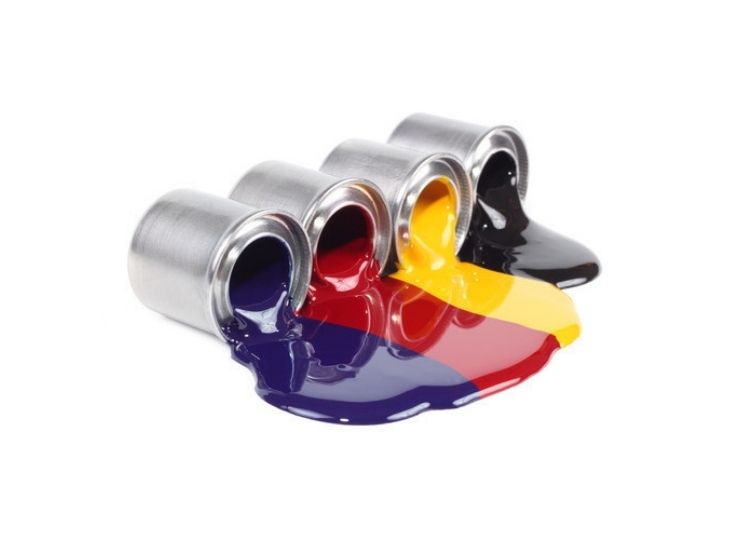Historical Overview
The roots of the printing press date back to the 10th century, when printed images were produced in Japan, and perhaps in China, from cut wooden blocks. The first movable type appeared in China in the 11th century while wooden type appeared in 14th century.
On the other hand, book production from woodblocks was introduced early in the 15th century in Europe. Later, in the middle of the 15th century Gutenberg came up with cast metal type. And all these inventions were the basis of letterpress printing – the original printing method.
The early printing process was an evolution of writing and drawing/painting, so it was only natural that the original printing inks were based on writing ink and paint. They used to consist of black or colored minerals which were dispersed in water-soluble gum. However, Gutenberg soon discovered that inks made from aqueous gum solutions did not wet metal surfaces. So, he composed an ink derived from the paints artists were using at that time. These paints were based on vegetable oils which were heated to increase their consistency and secured with natural rosin. Metal salts were also added to accelerate drying. The first clear record of ink composition dates back to the 17th century and was of this nature.
By the mid-18th century, printers who were skilled enough started creating their own inks. They modified the ink purchased from the specialist ink manufacturers by adding their own secret additives to it. They all followed the same basic composition. However, it was the use of other vegetable oils and natural resins that gave more details about the pigments and focused on the details of manufacturing methods. The role of the pigment is to provide the color characteristics of the ink. The resin is added as a dispersing aid and as a binder to secure the pigment to the paper. Oil is the medium for transferring pigments and resins from the printing press to paper. Additives are added to no-heat inks to control pigment wetting and dispersion, viscosity and flow properties, and provide a proper balance between ink and water.
Lithography
Offset Lithography is one of the most important and versatile printing process today. In 1796, Alois Senefelder introduced lithographic process in Germany. Lithography works because of the mutual repulsion of oil and water. This process initially used Bavarian limestone as the printing surface upon which images were drawn with greasy inks. These images were responsive to oil-based inks while the non-image surface was ink-repellent.
Senefelder named the process chemical printing. The technique quickly became a popular art medium as artists could produce multiple copies of freehand drawings. The inks needed to be modified and blended carefully to resist the water. The first lithographic inks were composed of beeswax, tallow soap and lampblack.
In 1920, the era of synthetic resin media started with the invention of phenol-formaldehyde resins and oil-soluble formulations. Later, in 1936, petroleum distillates were introduced – the basis of the majority of conventional letterpress and litho inks we use today.
Aniline printing
Around 1890, rotary letterpress printing originated from rubber printing plates, known as ‘aniline printing’. Aniline inks are made by dissolving aniline or coal tar dyes, in distilled water and adding a preservative. Over the last 30 years, the process has been refined and developed into a discrete process under the name of flexographic printing.
Intaglio inks
In 1852, an evolution of intaglio process occurred with the introduction of a method of etching the image onto the plate instead of relying on the highly skilled art of engraving. In the early days, the gravure inks were similar to those of intaglio printing.
Intaglio inks are composed of petroleum naphtha’s, resins, and coal tar solvents. The intaglio printing process is used mainly to print rotogravure newspaper supplements and cartons, labels, and wrappers.
By the end of the 19th century, ‘liquid’ inks were introduced. The earliest of those had been water-based and somewhat similar to the aniline inks of the time.
Screen printing
This process has been in use for many centuries. Earlier, there were no suitable inks available for screen printing. Although, it started gaining attention in the 1920s and became a convenient way of producing short runs of posters and for printing on difficult places such as glass.
Modern screen printing inks are based on a wide range of synthetic resins and polymers in a range of solvents with suitable volatility.
Ultraviolet (UV) Technology
This technology was introduced into printing ink formulation at the end of the 1960s. Initially, this technology was developed for lithography and letterpress printing but later it spread to screen ink formulations. Now, it is used both in flexography and gravure printing.
Modern Printing Ink Composition
Printing inks are a complex mixture of ingredients combined in a particular formulation to meet the desired properties of a printing application. The no-heat ink ingredients fall into four classifications – pigments, resins, oils, and additives.
Historically, newspaper inks were based on petroleum derivatives, but as prices rose in the 1980s, alternative oils were explored. Today’s ink manufacturers use both technologies, depending on cost structure, paper qualities, and customer requirements.
With rapidly changing technologies, automation and computer control, the printing and printing ink industry is no longer the same as it was 50 years ago. Today, lithography, letterpress, flexography, gravure, screen printing and several other modern printing techniques are there. Simple mechanisms are used by all these printing techniques to apply colorants to paper or plastic in order to form multiple reproductions of original images. Multiple colors can easily be printed in one pass through the press. And in order to reproduce specific colors, custom mixed inks are used and is widely used in package printing.


